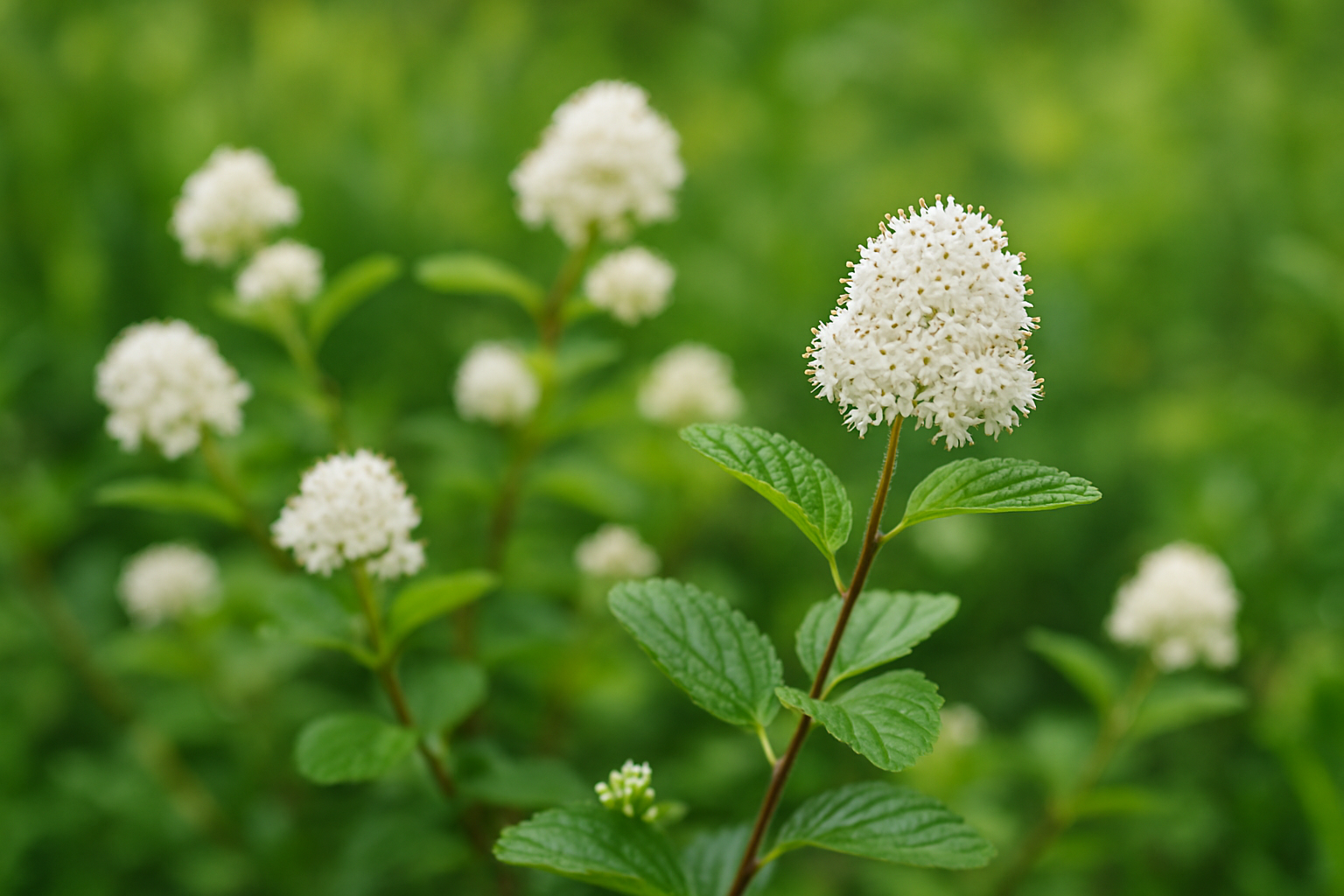New Jersey Tea Bush Native Plant Growing Guide

The New Jersey Tea Bush (Ceanothus americanus) is a native shrub from North America that has earned its stripes due to its important ecological role. It’s a team player in native plant gardens and restoration projects, blending in effortlessly and making for a practical and sustainable choice.
Getting to Know the New Jersey Tea Bush—Your New Garden's Best Friend
New Jersey Tea Bush is a deciduous shrub that usually pops up between 2 and 4 feet tall—just the right size to catch your eye without overwhelming the garden. It sports woody stems and ovate leaves edged with tiny serrations, giving it a bit of character. Come late spring, it lights up the landscape with clusters of delicate little white flowers.
This shrub naturally calls the eastern and central United States home where it’s quite happy growing in dry to moderately moist upland spots like prairies, oak woods, and sandy soils that might make you sweat a little. It tends to settle in USDA zones 3 through 8 and prefers basking in full sun but can tolerate some partial shade when needed.
- The leaves are simple and ovate edged with delicate serrations and typically measure about 1 to 2 inches long. They are just big enough to catch your eye without being showy.
- The flowers are small but pack a fragrant punch. They come in shades from white to creamy hues and usually gather tightly in little clusters that whisper rather than shout.
- When fully grown, this shrub settles anywhere between 2 and 4 feet tall and offers a humble yet charming presence.
- Leaves are not shy about changing their wardrobe. They shift from summer greens to vibrant yellows in the fall and add a subtle seasonal flair.
- Once the flowers have finished blooming, the plant gives you small dry seed pods with three distinct lobes, nature's little trifecta.
Why Ecology Matters and Why It Just Might Surprise You
New Jersey Tea Bush supports native pollinators like bees and butterflies. It serves as a larval host for some moth species and provides food and shelter to various birds.
Planting New Jersey Tea Bush is a real champion when it comes to keeping soil intact especially in spots where erosion likes to sneak in. Plus it does a neat trick by naturally fixing nitrogen which means you can ease up on those chemical fertilizers—always a win in my book. On top of that this hardy plant usually laughs off common pests and gives the whole landscape a bit of a survival boost.
"Using native plants like the New Jersey Tea Bush is absolutely vital for crafting gardens that do not just look good, but truly support local wildlife, boost soil health, and keep chemical use to a bare minimum. In fact, it often acts as a cornerstone species in many ecological restoration projects, quietly doing a lot of heavy lifting behind the scenes." — Dr. Emily Harper, Native Plant Ecologist
Getting Started with Planting New Jersey Tea Bushes A Simple Guide to Growing These Charming Shrubs
New Jersey Tea Bush can be grown from seeds, semi-hardwood cuttings or nursery-grown plants. Growing from seeds offers genetic variety but usually requires patience as they take time to develop. Cuttings root quicker but demand a watchful eye and tender loving care.
When fall arrives, collect mature seed pods and gently coax the seeds out. Take your time and handle them like tiny treasures.
Place the seeds in the fridge at 4°C for 60 to 90 days. This cold period helps wake them from dormancy.
Plant the seeds in a well-draining seed-starting mix, covering them lightly with soil. Think of it as tucking them in for a cozy start.
In late summer, cut semi-hardwood cuttings about 4 to 6 inches long. Make sure each cutting has a few leaf nodes to keep things lively.
Quickly dip the cuttings in rooting hormone, then place them somewhere humid with indirect light. Wait patiently for roots to appear and check on them occasionally, but try not to disturb them too much.
Pick a spot that soaks up full sun or enjoys a bit of morning shade with soil that drains well and has a pH around 5.5 to 7.0, leaning from slightly acidic to neutral. Make sure there’s enough elbow room for the plant to stretch out, usually about 3 to 4 feet wide. Keep the moisture in check without turning the soil into a mud bath.
| Parameter | Optimal Range | Impact on Plant Health |
|---|---|---|
| Sun Exposure | Full sun to partial shade | Absolutely key for vibrant blooms and sturdy growth — plants do love their sunshine! |
| Soil pH | 5.5 - 7.0 | Plays a key role in nutrient uptake, keeping your plants happy and thriving with just the right balance. |
| Soil Moisture | Well-drained, moderately moist | Keeps roots from drowning or drying out — the Goldilocks zone for moisture, if you will. |
| Soil Texture | Sandy to loamy | Encourages roots to spread out nicely, setting the stage for a healthy plant foundation. |
| Spacing | 3 to 4 feet apart | Boosts airflow between plants, cutting down disease risk — think of it as giving your plants some personal space to breathe. |
Getting the Soil Ready and Planting Tips You’ll Actually Use
Getting your soil ready the right way is absolutely key. Start by running a pH test and tackle any nutrient shortfalls you spot — don’t just wing it. Be generous with organic matter like compost because it acts like a spa treatment for the soil and boosts both nutrients and texture. When it’s time to plant, dig holes twice as wide as the root ball and make sure to set the plant right at the root collar depth.
- Test your soil to get a good sense of its pH and nutrient levels before you start planting.
- Gently mix in some organic compost or well-aged manure to boost your soil's fertility and texture. This is nature’s way of giving your plants a great head start.
- Dig a few test holes to check how well your soil drains because you don’t want water pooling like an unwelcome guest.
- Clear out any pesky weeds and grasses from the area so your plants won’t have to compete for attention.
- When making planting holes, go for at least twice the width of the root ball. This gives the roots plenty of room to stretch out and thrive.
The best times to plant are early spring or fall when temperatures are nice and mild, giving the plant a fair shot at settling its roots before the summer heat or winter chill roll in.
How to Care for and Maintain Your New Jersey Tea Bush Like a Pro
The New Jersey Tea Bush appreciates moderate watering. It’s pretty tough when the drought kicks in but tends to perk up a lot more with a good, deep drink if those dry spells drag on. Just watch out for overdoing it — too much water can lead to root rot, which no one wants.
Fertilize New Jersey Tea Bush only when it’s truly needed because it’s a bit of a self-starter. It naturally fixes its own nitrogen and generally does not ask for much extra fertilizer. If you notice the plant dragging its feet in early spring, a balanced slow-release organic fertilizer can give it a gentle nudge. Avoid fertilizers that are heavy on nitrogen since they tend to make the leaves grow wildly while the flowers lag behind.
Prune lightly after flowering to keep the shape looking neat and to snip out any dead or crossing branches that are just getting in the way. Doing this usually encourages healthy growth and often means you’ll enjoy even more abundant blooms the following year.
- During dry spells, give your plants a good deep drink about once a week but ease up when the weather turns wetter—no need to overdo it.
- Prune right after the spring bloom to keep things looking neat and the plant feeling its best.
- Take a quick peek at your plants every month for any unwelcome pests or pesky diseases. Catching these early can save you a lot of headaches down the line.
- Each early spring a light sprinkle of organic fertilizer or a bit of compost helps kickstart new growth.
Managing Pests and Diseases A Practical Guide to Keeping Your Garden Happy
While the New Jersey Tea Bush is generally a hardy little fellow it’s not completely immune to trouble. Aphids, scale insects or fungal diseases can occasionally sneak in. Catching early warning signs like warped leaves or discolored spots can save the day. This allows you to jump in with organic treatments like insecticidal soaps or neem oil before things get out of hand.
- Aphids often cause leaves to curl up like little green fists and leave behind a sticky residue that’s hard to miss.
- Scale insects tend to show up as tiny, immobile bumps clinging stubbornly to stems and leaves almost like uninvited guests who refuse to leave.
- Powdery mildew shows itself as white, powdery spots that spread like a bad rumor.
- Leaf spot diseases create brown or black spots on the foliage giving your plants that 'battle scar' look.
- Root rot usually sneaks in thanks to overwatering or poorly draining soils.
Integrated pest management is about watching pests without going overboard and encouraging friendly insects like ladybugs to do their thing. You only step in with treatments when it is truly called for. Pruning to boost airflow and avoiding watering from above can cut down the risk of fungal infections.
Inspiring Ideas to Spark Your Creativity and Bring Your Landscape to Life
Add New Jersey Tea Bush to native gardens and habitats to attract pollinators and craft natural borders. It gives biodiversity a nice boost and pairs beautifully with other native plants like butterfly weed and coneflowers, painting a lively wildlife-friendly scene.
- Use it as a low hedge or border plant to softly frame your garden spaces. Nothing too stiff, just a gentle nudge to define areas.
- Toss it into butterfly gardens to lend a helping hand to a bunch of busy pollinators fluttering about.
- Plant it along slopes or embankments where it can quietly get to work taming soil erosion as a natural bodyguard for your earth.
- Pair it with companion plants that share its water and light preferences because they’ll get along like old friends.
- Blend it with flowering perennials to keep your garden’s charm going strong through the seasons without missing a beat.
New Jersey Tea Bush quietly steals the show with its visual charm. Its fragrant white flowers pop up in spring to brighten your day while the lush green leaves stick around all summer long. Just when you think the garden’s winding down, vibrant yellow fall foliage pops in with a last burst of color before winter calls it a day.

New Jersey Tea Bush showcasing dense white flower clusters and vibrant green leaves in natural habitat
Harvesting and Some Good Old-Fashioned Uses
Back in the American colonial era the New Jersey Tea Bush was highly valued as a homegrown substitute for imported tea, lovingly gathered by both Native Americans and settlers alike. Responsible harvesting usually means snipping just a few leaves here and there—never taking more than the plant can handle—so it stays healthy and keeps doing its part in the ecosystem.
The leaves of the new jersey tea bush are carefully dried and steeped to brew a gentle, fragrant tea that's as comforting as it is soothing. Indigenous peoples cleverly used various parts of this plant in traditional remedies to tackle respiratory and digestive troubles.





